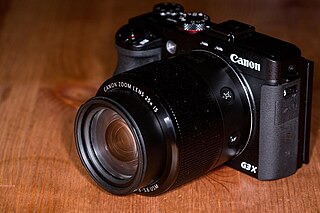
A digital camera is a camera that captures photographs in digital memory. Most cameras produced today are digital, largely replacing those that capture images on photographic film. Digital cameras are now widely incorporated into mobile devices like smartphones with the same or more capabilities and features of dedicated cameras. High-end, high-definition dedicated cameras are still commonly used by professionals and those who desire to take higher-quality photographs.

A point-and-shoot camera, also known as a compact camera and sometimes abbreviated to P&S, is a still camera designed primarily for simple operation. Most use focus free lenses or autofocus for focusing, automatic systems for setting the exposure options, and have flash units built in. They are popular for vernacular photography by people who do not consider themselves photographers but want easy-to-use cameras for snapshots of vacations, parties, reunions and other events.

Cyber-shot is Sony's line of point-and-shoot digital cameras introduced in 1996. Cyber-shot model names use a DSC prefix, which is an initialism for "Digital Still Camera". Many Cyber-shot models feature Carl Zeiss trademarked lenses, while others use Sony, or Sony G lenses.

Bridge cameras are cameras that fill the niche between relatively simple point-and-shoot cameras and interchangeable-lens cameras such as mirrorless cameras and single-lens reflex cameras (SLRs). They are often comparable in size and weight to the smallest digital SLRs (DSLR), but lack interchangeable lenses, and almost all digital bridge cameras lack an optical viewfinder system. The phrase "bridge camera" has been in use at least since the 1980s, and continues to be used with digital cameras. The term was originally used to refer to film cameras which "bridged the gap" between point-and-shoot cameras and SLRs.
The Sony Cyber-shot DSC-TX5 is a digital still camera announced by Sony on February 18, 2010. It boasts advanced features like Backlight Correction HDR, Hand-Held Twilight aided by the Exmor R CMOS sensor, and the intelligent panorama stitching mode, called the iSweep. The camera also has a waterproof body, which also makes it dust-proof. It is also freeze-proof for up to -10° Celsius and shock-proof, when dropped from a height of about 1.5 meters. Sony describes it as a rugged camera.
The Sony Cyber-shot DSC-RX100 series is a high-end compact camera part of the wider Sony RX series. It started with the DSC-RX100, announced on 6 June 2012, and is part of the Cyber-shot RX line of digital cameras made by Sony. Seven annual generations have been released so far until 2019, all equipped with a one-inch 20-Megapixel image sensor and rotary knob around the lens. Filming at up to 1080p at 60fps is supported by the first three generations, the third additionally with 720p at 120fps, and up to 2160p (4K) at 30fps and 1080p at 120fps high frame rate video since the fourth.

The Sony Cyber-shot DSC-HX200V is a hyperzoom bridge digital camera that features:

The Sony Cyber-shot DSC-RX10 is a digital superzoom bridge camera made by Sony. It was announced on October 16, 2013.

The Sony Cyber-shot DSC-HX400V is a hyperzoom bridge digital camera that features:
The Sony Cyber-shot DSC-QX30 is an ultrazoom, mobile device-mountable, lens-type compact camera manufactured by Sony. Announced on September 3, 2014, the QX30 is one of Sony's "Smart Lens" cameras, alongside the QX1, QX10 and QX100, that are designed to be specifically used with a smartphone. It has a 1/2.3 inch backside-illuminated Exmor R™ CMOS sensor with 20.4 effective megapixels, sitting behind an ƒ/3.5 (wide) to ƒ/6.3 (telephoto) Sony G Lens. Its highlight feature is its 30x lossless optical zoom.

The Sony Cyber-shot DSC-HX50 is a hyperzoom camera with 30x optical zoom, released in 2013.

The Canon PowerShot G3 X is a large sensor digital bridge camera announced by Canon on June 18, 2015. It marks Canon's entry into this product category, alongside competitors such as the Panasonic Lumix DMC-FZ1000, Sony Cyber-shot RX10 and RX10 II.

The Sony RX is the name of a range of fixed lens compact point-and-shoot digital cameras created by Sony in 2012. All cameras are equipped with Carl Zeiss lenses.

The Sony Cyber-shot DSC-QX100 is a mobile device-mountable lens-type compact camera manufactured by Sony. Announced on September 3, 2014, the QX100 is one of Sony's "Smart Lens" cameras, alongside the QX1, QX10 and QX30, that are specifically designed to be used with a smartphone. Its highlight features are its 1-inch backside-illuminated Exmor R CMOS sensor taken straight from the Sony RX100 II premium compact camera, with 20.2 megapixels, ƒ/1.8 to ƒ/4.9 Carl ZEISS® Vario-Sonnar T* lens and a 3.6x (28–100 mm) optical zoom.

The Sony Cyber-shot DSC-WX500 is a digital selfie compact camera, which can zoom up to 30x; equivalent to 24–720 mm. The WX500 is mainly used for selfies, not made for vlogging.












